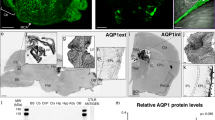Summary
Utilizing horseradish peroxidase as a tracer, electron microscopic studies were done on the blood-optic nerve and fluid-optic nerve barrier to the peroxidase diffusion. Following intravenous injection the peroxidase was observed to fill the lumen of the capillaries of the laminar, prelaminar and orbital portions of the optic nerve but there was no penetratation of the capillary walls. The obstruction of the tracer diffusion out of capillary walls was attributed to the tight junctions between the endothelial cells. Peroxidase penetration was also absent in the capillaries of the pia and dura mater, however, was observed in pinocytotic vesicles of the endothelial cells.
Lateral diffusion from the surrounding choroid into the optic nerve was detected but diffusion from the prelaminar optic nerve into the juxta-optic nerve retina was prevented by the Kuhnt intermediary tissue. Tight junctions which prevented peroxidase diffusion were found between the glial cells of the Kuhnt tissue, and this tissue was the barrier between the prelaminar optic nerve and the juxta-optic nerve retina.
Peroxidase which was given into the lateral ventricle of the brain appeared in the subarachnoidal space around the optic nerve and penetrated freely into the optic nerve. The pial surface of the optic nerve possess no barrier activity. Peroxidase could be traced along the intercellular space between glial cells and optic nerve fibers. The basal lamina of the optic nerve capillaries was filled with peroxidase but diffusion into the capillary lumen was obstructured by the tight junctions between the endothelial cells.
Zusammenfassung
Mit Hilfe von Meerrettich-Peroxidase wurden elektronenmikroskopische Tracer-Studien an der Blutsehnerven- und Liquorsehnervenbarriere unternommen. Nach intravenöser Injektion von Peroxidase füllte diese das Lumen der Capillaren des laminaren, prälaminären und Orbitalen Anteiles des Nervus opticus aus, ohne daß eine Penetration der Capillarwände zu beobachten war. Die Verhinderung einer Tracerdiffusion durch die Capillarwand wurde den “tight junctions” zwischen den Endothelzellen zugeschrieben. Auch bei den Capillaren der Pia und Dura fand sich keine Penetration von Peroxidase. Es wurden jedoch mit Peroxidase gefüllte pinocytotische Vesikel im Endothel beobachtet. Während eine laterale Diffusion von Peroxidase von der umgebenden Chorioidea in den Sehnerven festgestellt wurde, wurde eine Diffusion des Tracers vom prälaminären Anteil des Sehnerven in das umgebende Retinagewebe durch das Kuhnt'sche Zwischengewebe blockiert. “Tight junctions”, die eine Diffusion von Peroxidase verhinderten, fanden sich zwischen den Gliederzellen des Kuhnt'schen Gewehes, so daß dieses Gewebe als Barriere zwischen dem prälaminären Anteil des Sehnerven und der juxtapapillären Netzhaut wirkte.
Peroxidase, die in einen Seitenventrikel des Gehirns appliziert wurde, erschien in dem den Sehnerven umgebenden Subarachnoidalraum und diffundierte ungehindert in den Sehnerven. Die Pia Mater des Sehnerven hatte somit keine Barrierenfunktion. Peroxidase konnte entlang den Intercellularspalten zwischen Gliazellen und Sehnervenfasern verfolgt werden. Die Basalmembran der Capillaren des Sehnerven war angefüllt mit Peroxidase. Eine Diffusion in das Capillarlumen wurde jedoch durch die “tight junctions” zwischen den Endothelzellen verhindert.
Similar content being viewed by others
References
Anderson, D. R.: Ultrastructure of meningeal sheath. Arch. Ophthal. 82, 659–674 (1969)
Cohen, A. I.: Is there a potential defect in the blood-retinal barrier at the choroidal level of the optic nerve canal ? Invest. Ophthal. 12, 513–519 (1973)
Grayson, M. C., Laties, A. M.: Ocular localization of sodium fluorescein. Arch. Ophthal. 85, 600–609 (1971)
Peyman, C. A., Apple, D.: Peroxidase diffusion processes in the optic nerve. Arch. Ophthal. 88, 650–654 (1972)
Rodriguez-Peralta, L. A.: Hematic and fluid barriers in the optic nerve. J. comp. Neurol. 126, 109–118 (1966)
Tansley, K.: Comparison of the lamina cribrosa in mammalian species with good and with indifferent vision. Brit. J. Ophthal. 40, 178–182 (1956)
Tsukahara, I., Ota, M.: Histologic study on the distribution of sodium fluorescein in the fundus. Functional Examination in Ophthalmology (4th Congress of the European Society of Ophthalmology, Budapest, 1972). Francois, J., ed., p. 307–311. Basel: Karger 1974
Yamashita, H., Miki, H., Tsukahara, I., Ogawa, K.: A Histochemical study on the bloodoptic nerve and fluid-optic nerve barrier. Acta histochem. cytochem. 6, 163–170 (1973)
Author information
Authors and Affiliations
Additional information
This study was supported by Grants No 848199 (1973) and No 948231 (1974) from the Education Ministry of Japan.
This paper was read, in part, before the 22nd International Congress of Ophthalmology, Paris, 1974 and the International Symposium on Vascular Diseases of Optic Nerve, Catania, 1975.
Rights and permissions
About this article
Cite this article
Tsukahara, I., Yamashita, H. An electron microscopic study on the blood-optic nerve and fluid-optic nerve barrier. Albrecht von Graefes Arch. Klin. Ophthalmol. 196, 239–246 (1975). https://doi.org/10.1007/BF00410035
Received:
Issue Date:
DOI: https://doi.org/10.1007/BF00410035




